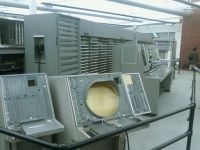SAGE and the Origins of Modern Computing
An old, rare IBM film about SAGE recently surfaced on YouTube -- what a fantastic resource that web site is. The film brought back many discussions I've had with my colleagues about the place of SAGE in the history of computing. Paul Edwards saw SAGE as the centerpiece of the "Closed World" of computing. IBM historians have discussed its role in propelling that company into the forefront of commercial computing after 1960. Others have discussed SAGE as the precursor of networked computing, a pioneer in graphical user interfaces, in real-time computing--the list goes on.
 In 1989, the Smithsonian's National Air and Space Museum opened an exhibit about computing and aerospace, and among the artifacts it displayed is a SAGE core memory unit. (The photo here is of a complete system on display at the Computer History Museum.) Not long after it opened, I took a retired SAGE engineer through the exhibit. When we got to the memory unit, he turned to me and said, "You know, it never would have worked. Had there been an attack, SAGE would have immediately become overloaded, and no signals would have gotten through." Later on I mentioned this to another veteran of the project, who told me the engineer was flat-out wrong. We'll never know. The Soviet Union never launched a bomber attack over the Nortth Pole. It is worth mentioning, however, that Paul Baran of the RAND Corporation proposed a scheme of distributed communications that, in his view, would be far more robust than SAGE's top-down topology. Baran's work is cited as a precursor to the packet-switched scheme that is the basis for today's Internet. And despite a number of deliberate attacks, natural disasters, and other disruptions, the Internet has managed to be very robust as it has scaled up orders of magnitude over the past two decades.
It may be time for historians to have another look at SAGE.
In 1989, the Smithsonian's National Air and Space Museum opened an exhibit about computing and aerospace, and among the artifacts it displayed is a SAGE core memory unit. (The photo here is of a complete system on display at the Computer History Museum.) Not long after it opened, I took a retired SAGE engineer through the exhibit. When we got to the memory unit, he turned to me and said, "You know, it never would have worked. Had there been an attack, SAGE would have immediately become overloaded, and no signals would have gotten through." Later on I mentioned this to another veteran of the project, who told me the engineer was flat-out wrong. We'll never know. The Soviet Union never launched a bomber attack over the Nortth Pole. It is worth mentioning, however, that Paul Baran of the RAND Corporation proposed a scheme of distributed communications that, in his view, would be far more robust than SAGE's top-down topology. Baran's work is cited as a precursor to the packet-switched scheme that is the basis for today's Internet. And despite a number of deliberate attacks, natural disasters, and other disruptions, the Internet has managed to be very robust as it has scaled up orders of magnitude over the past two decades.
It may be time for historians to have another look at SAGE.
 In 1989, the Smithsonian's National Air and Space Museum opened an exhibit about computing and aerospace, and among the artifacts it displayed is a SAGE core memory unit. (The photo here is of a complete system on display at the Computer History Museum.) Not long after it opened, I took a retired SAGE engineer through the exhibit. When we got to the memory unit, he turned to me and said, "You know, it never would have worked. Had there been an attack, SAGE would have immediately become overloaded, and no signals would have gotten through." Later on I mentioned this to another veteran of the project, who told me the engineer was flat-out wrong. We'll never know. The Soviet Union never launched a bomber attack over the Nortth Pole. It is worth mentioning, however, that Paul Baran of the RAND Corporation proposed a scheme of distributed communications that, in his view, would be far more robust than SAGE's top-down topology. Baran's work is cited as a precursor to the packet-switched scheme that is the basis for today's Internet. And despite a number of deliberate attacks, natural disasters, and other disruptions, the Internet has managed to be very robust as it has scaled up orders of magnitude over the past two decades.
It may be time for historians to have another look at SAGE.
In 1989, the Smithsonian's National Air and Space Museum opened an exhibit about computing and aerospace, and among the artifacts it displayed is a SAGE core memory unit. (The photo here is of a complete system on display at the Computer History Museum.) Not long after it opened, I took a retired SAGE engineer through the exhibit. When we got to the memory unit, he turned to me and said, "You know, it never would have worked. Had there been an attack, SAGE would have immediately become overloaded, and no signals would have gotten through." Later on I mentioned this to another veteran of the project, who told me the engineer was flat-out wrong. We'll never know. The Soviet Union never launched a bomber attack over the Nortth Pole. It is worth mentioning, however, that Paul Baran of the RAND Corporation proposed a scheme of distributed communications that, in his view, would be far more robust than SAGE's top-down topology. Baran's work is cited as a precursor to the packet-switched scheme that is the basis for today's Internet. And despite a number of deliberate attacks, natural disasters, and other disruptions, the Internet has managed to be very robust as it has scaled up orders of magnitude over the past two decades.
It may be time for historians to have another look at SAGE.
